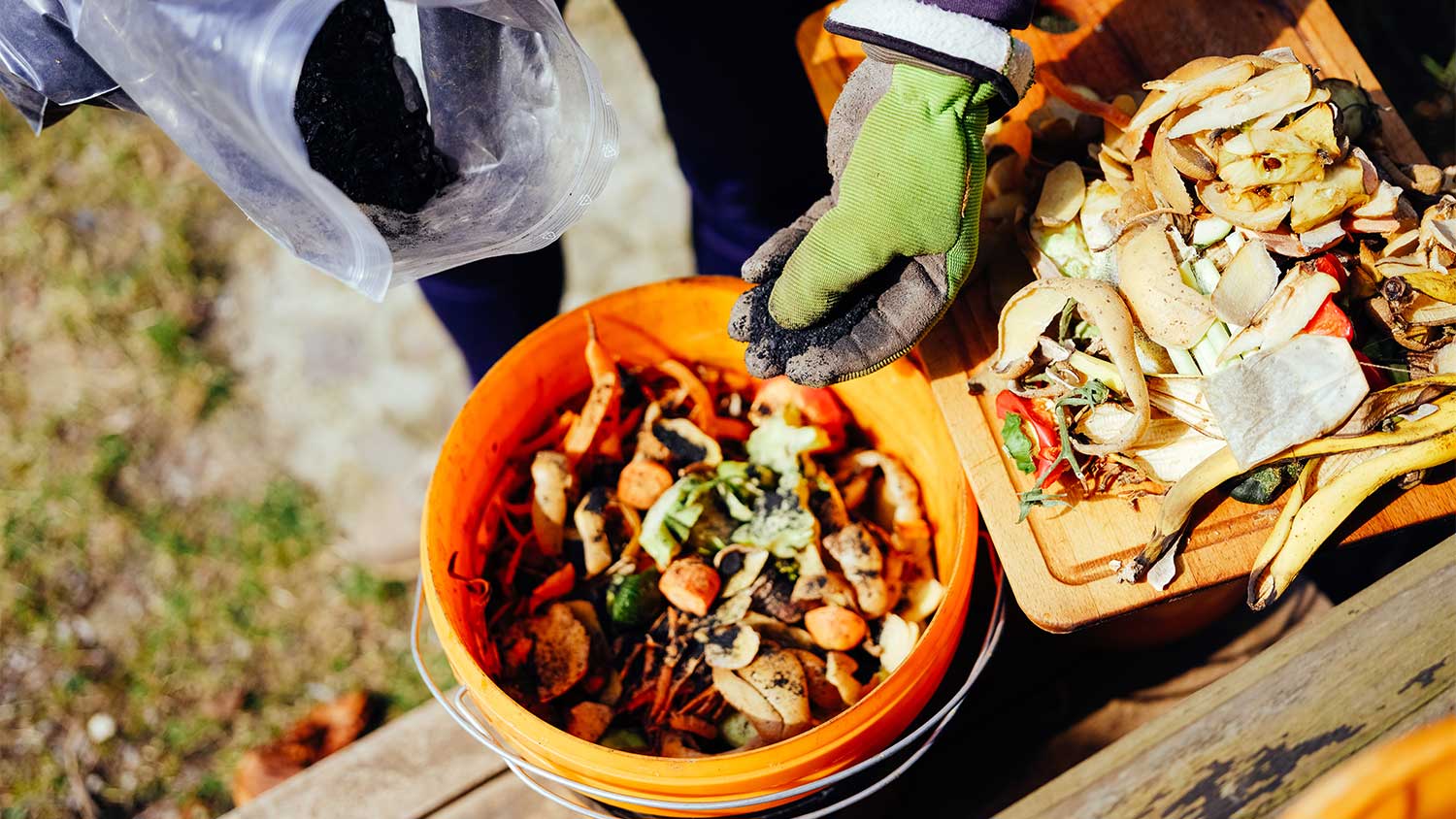
Landscape curbing can really improve the look of a yard, but at what cost? Find out how much it costs and the different ways you can do it
Fermentation isn’t just for your kombucha or that jar of pickles


Bokashi is a fermented, pre-compost method.
It can take just 10 days to complete the Bokashi method.
Bokashi is anaerobic, while traditional compost is aerobic.
Bokashi bran contains microbes that break down food waste.
You must add Bokashi to compost or soil to complete the composting process.
For most garden fanatics, composting is akin to gold, providing the soil with rich nutrients that make for extra vibrant and tasty plants. But what if there was a lesser-known composting method that could actually speed up the composting process? Introducing bokashi composting, the 10ish-day composting method.
Bokashi is Japanese for “fermented organic matter.” This matter is a pre-composting method that ferments food waste in an airtight container to speed up the composting process.
Users sprinkle in Bokashi bran between each layer of food waste and scraps, which, unlike your Bran Flakes cereal, is a mixture of wheat or rice bran, water, molasses, or some other type of sugar, and the inoculation of essential microbes (EMs). These EMs multiply very fast as they break down the sugars and food scraps. The result? An anaerobic environment that is prime for the compost pile.
Bokashi differs from traditional composting in several ways. The biggest difference is that a compost pile breaks down matter with the help of oxygen-respiring aerobic bacteria. Much like an aerobic workout, these aerobic bacteria need oxygen to survive.
Bokashi, on the other hand, doesn’t actually decompose the waste. Instead, it ferments the waste and preserves scraps in a semi-decomposed state for turning into mature compost later.
Though Bokashi is not an ultimate solution to faster composting, combined with traditional or vermicomposting using worms, the Bokashi method can provide a powerful means for faster, high-quality compost.
On the surface, Bokashi may look like it complicates the composting process. You are, after all, adding in additional steps to conventional composting; however, it can actually be simpler and more flexible than traditional composting.
But there’s more to it than just that. Here are the pros to using Bokashi:
Regular composting often has a steep learning curve because of variables ranging from pests to climate. Humidity, for example, influences the materials and maintenance that a compost pile needs and what nutrients the soil needs from the compost.
A failed first attempt at composting can feel especially deflating, given that months of work may go into it. Some homeowners find Bokashi easier to master because it’s typically done in small batches that are ready faster than a large pile, making it more of a practice-as-you-go than a wait-and-see process.
When making traditional compost, the faster you want mature compost, the more you have to aerate the pile (i.e., turn it with a shovel or pitchfork) so that oxygen reaches the aerobic bacteria. You must also maintain a healthy carbon-nitrogen balance by mixing the right amount of brown and green materials. All of this can be a pain if you rely mostly or entirely on kitchen waste, which isn’t exactly consistent.
With Bokashi, proportions don’t matter as much. Likewise, it doesn’t matter if you toss in cooked or raw foods. Even meat, dairy, and bones can go in, whereas you generally avoid these items with traditional composting.
Less labor is involved, too. One of the most demanding parts of maintaining Bokashi compost is rinsing out the bucket before starting a new batch.
Bokashi is perfect for a countertop, in the pantry, or next to the garbage bin, thanks to compact systems such as the Bokashi Bucket, which blends in with your countertop items—just don’t forget it’s not a cookie jar!
Once you become more experienced, you can scale for greater output. Some experienced Bokashi users cycle two buckets at a time or expand to larger storage drums and 50-gallon industrial trash bags to haul all of the fermented matter.
While every rose has its thorns, Bokashi has very few. Regardless, here are the cons to Bokashi:
Bokashi requires an additional step to the composting process. Since it’s not technically compost, you have to add the fermented matter to a traditional compost bin, vermicompost bin, or to trenches in the soil that don’t directly reach your plants, which can’t handle the acidity.
Bokashi requires special equipment and materials. You need an air-tight, drainable container to drain when liquids get too great. You also need to purchase Bokashi bran.
Bokashi is a rewarding method that you can DIY with the right materials. Here’s how you can make Bokashi in your home.
Gather the materials. You’ll need a Bokashi bucket that has a tight-fitting lid and a spigot on the bottom for draining liquids. You’ll also need Bokashi bran, which you can buy online or make with molasses, water, and EM microbes.
Fill the bucket with scraps. Over a week, toss in food scraps. Every time you add a layer, sprinkle on some bran—about one tablespoon of bran for each cup of food scraps—then, squash the scraps down into the bucket (trapped air inhibits anaerobic activity) and put the lid back on.
Let the bucket sit. Once your bokashi bin or bucket is full, put it in a dark, cool, out-of-the-way spot with the lid sealed. Let the bucket sit for at least a week but ideally for two weeks.
Drain the liquid. Every one to two days, drain off the liquid, or leachate. Dilute it with water to make a potent tea for your plants. Never apply it undiluted, though. If you’re short on time, just pour it down the sink.
Finish the compost. After one to two weeks, the scraps are ready for finishing into mature compost.

Before you toss fermented Bokashi onto your plants, you need to complete the composting process. Here’s a look at a few common methods for using Bokashi for composting and in the garden:
Bury it. Dig a hole or trench about a foot deep, put in the bokashi scraps, and cover with three or four inches of dirt. Let it sit for at least two weeks.
Make a soil factory. A soil factory contains the burying in a large bucket or plastic bin, making it ideal for small garden spaces. Use living, active soil instead of sterile potting soil, or the scraps won’t break down.
Add to regular compost. You can speed up traditional composting with Bokashi, but avoid using too much meat and dairy and pay attention to the carbon-nitrogen balance.
Feed it to worms. Bokashi pre-compost can also enhance vermicomposting. Rinse the pre-compost before letting the worms snack on it, though. Then, add it in slowly so as not to shock the worms.
From average costs to expert advice, get all the answers you need to get your job done.

Landscape curbing can really improve the look of a yard, but at what cost? Find out how much it costs and the different ways you can do it

A landscape designer can elevate your outdoor space and bring your vision to life. Use this landscape design cost guide to budget for your next project.

Leveling your yard can help with drainage and prevent damage to your home. Learn the cost to level a yard in Columbus, OH, and what factors can affect the price.

Artificial grass can enhance your home’s curb appeal with very little upkeep. Learn how to choose the artificial grass that’s right for your yard.

Try these 10 backyard improvements to turn your backyard into your own personal oasis.

If you’re trying to prevent erosion in your yard, riprap might be the right material for your project. So, what is riprap, exactly? Let’s walk through it.